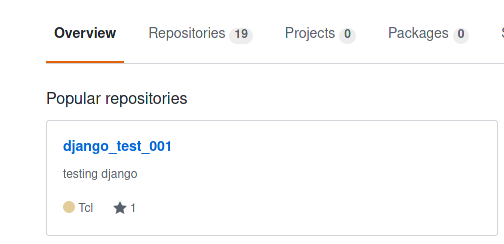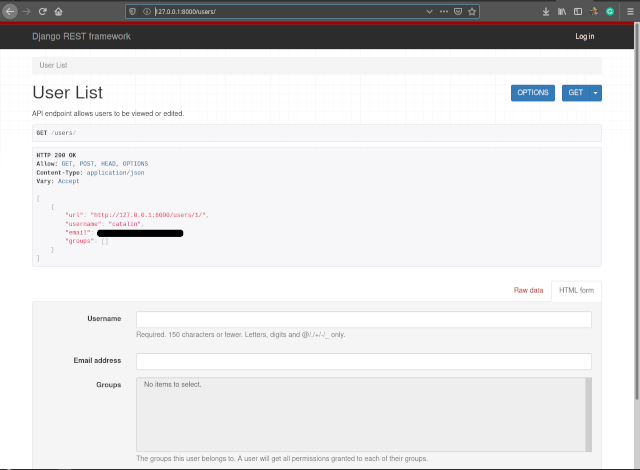The PyMongo python package is a Python distribution containing tools for working with MongoDB.
The full documentation can be found on this webpage.
You can see my tutorial about how to install the MongoDB into Fedora 31 on this webpage.
I used that webpage install to test this python package, see the result:
[mythcat@desk mongo_test]$ mongo
...
MongoDB server version: 4.2.2-rc1
> use admin
switched to db admin
> show dbs
> db.auth('admin', 'admin')
1
> show dbs
admin 0.000GB
config 0.000GB
local 0.000GB[mythcat@desk projects]$ pip3 install pymongo --user
Collecting pymongo
...
Successfully installed pymongo-3.10.0[mythcat@desk projects]$ mkdir mongo_test
[mythcat@desk projects]$ cd mongo_test/
[mythcat@desk mongo_test]$ vim mongo001.py> use admin;
switched to db admin
> db.grantRolesToUser('admin', [{ role: 'root', db: 'admin' }])import pymongo
from pymongo import MongoClient, errors
MONGO_URI = 'mongodb://admin:admin767779@127.0.0.1:27017/admin'
client = pymongo.MongoClient(MONGO_URI)
print("Server info : ")
print(client.server_info())
print("Databases : " + str(client.list_database_names()))
print("Connect to : admin database!")
db = client['admin']
db2 = client.config
print(db)
print(db2)
print("Collection admin : ")
collection = db['admin']
collection2 = db.config
print(collection)
print(collection2)
print("try call find_one method")
try:
one_doc= collection2.find_one()
print ("find_one():", one_doc)
except errors.ServerSelectionTimeoutError as err:
print ("find_one() ERROR:", err)
print("Client close!")
client.close()[mythcat@desk mongo_test]$ python3 mongo001.py
Server info :
{'version': '4.2.2-rc1', 'gitVersion': 'a0bbbff6ada159e19298d37946ac8dc4b497eadf', 'modules': [],
'allocator': 'tcmalloc', 'javascriptEngine': 'mozjs', 'sysInfo': 'deprecated', 'versionArray': [4, 2, 2, -49],
'openssl': {'running': 'OpenSSL 1.1.1d FIPS 10 Sep 2019', 'compiled': 'OpenSSL 1.1.1 FIPS 11 Sep 2018'},
'buildEnvironment': {'distmod': 'rhel80', 'distarch': 'x86_64', 'cc': '/opt/mongodbtoolchain/v3/bin/gcc:
gcc (GCC) 8.2.0', 'ccflags': '-fno-omit-frame-pointer -fno-strict-aliasing -ggdb -pthread -Wall -Wsign-compare
-Wno-unknown-pragmas -Winvalid-pch -Werror -O2 -Wno-unused-local-typedefs -Wno-unused-function
-Wno-deprecated-declarations -Wno-unused-const-variable -Wno-unused-but-set-variable
-Wno-missing-braces -fstack-protector-strong -fno-builtin-memcmp', 'cxx': '/opt/mongodbtoolchain/v3/bin/g++:
g++ (GCC) 8.2.0', 'cxxflags': '-Woverloaded-virtual -Wno-maybe-uninitialized -fsized-deallocation -std=c++17',
'linkflags': '-pthread -Wl,-z,now -rdynamic -Wl,--fatal-warnings -fstack-protector-strong -fuse-ld=gold -Wl,
--build-id -Wl,--hash-style=gnu -Wl,-z,noexecstack -Wl,--warn-execstack -Wl,-z,relro', 'target_arch':
'x86_64', 'target_os': 'linux'}, 'bits': 64, 'debug': False, 'maxBsonObjectSize': 16777216, 'storageEngines':
['biggie', 'devnull', 'ephemeralForTest', 'wiredTiger'], 'ok': 1.0}
Databases : ['admin', 'config', 'local']
Connect to : admin database!
Database(MongoClient(host=['127.0.0.1:27017'], document_class=dict, tz_aware=False, connect=True), 'admin')
Database(MongoClient(host=['127.0.0.1:27017'], document_class=dict, tz_aware=False, connect=True), 'config')
Collection admin :
Collection(Database(MongoClient(host=['127.0.0.1:27017'], document_class=dict, tz_aware=False, connect=True),
'admin'), 'admin')
Collection(Database(MongoClient(host=['127.0.0.1:27017'], document_class=dict, tz_aware=False, connect=True),
'admin'), 'config')
try call find_one method
find_one(): None
Client close!



